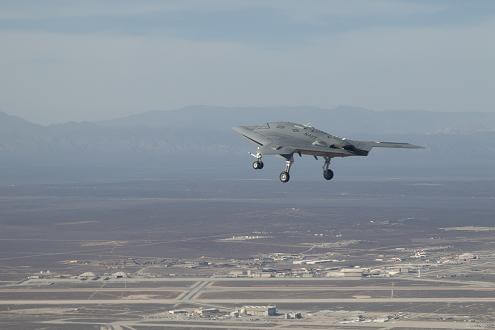Robot Jet Fighter Takes First Flight, Aims for Aircraft Carriers in 2013

Share
Navy officials and military developers are beaming with smiles of success for they are the proud papas of the newest military marvel: a robotic jet fighter. The X-47B, built by Northrop Grumman, completed its first successful test flight on February 4th at Edwards Air Force Base in California without the assistance of an onboard or remote human pilot. It's all automated. The aircraft's sleek tailless design will make it harder to spot on radar, but proves a unique challenge for an unmanned aerial system (UAS). Yet the X-47B pulled off the historic test flight with great success, as you'll see in the video below. The task ahead will prove much harder. The US Navy is looking to place the robot jet fighter on aircraft carriers in the next decade, with ocean-located trials slated for 2013. From there, robotic jet fighters could prove to be valuable assets in a modern military that is increasingly automating its approach to war.
The X-47B made a short 29 minute, 5000 foot flight, without difficulty, taking a few passes around the airstrip. At this point Northrop Grumman was really only testing the guidance and navigation systems, but according to the press release, they'll be expanding the UAS' aerial repertoire in the months ahead before moving the aircraft to Maryland later in the year. The footage in the video below may seem pretty calm, but remember you're watching a high quality jet fighter fly without any human assistance either in or outside the craft.
Part of the Unmanned Combat Air System Demonstration project (UCAS-D), the X-47B is something beyond the drones and UAVs you see in action today. It's not a spy, nor a single-target hunter-killer, it's a complete jet fighter. The 60 foot wingspan, 40,000 altitude, and 2100 nautical mile flight range, not to mention 4500 lb weapon bays, speak of an aircraft that would be a high end component of the military of the future. It will have more range (though less firepower) than the F-18 Hornets commonly used today. Imagine wings of these fighters being launched from aircraft carriers positioned out of the reach of anti-carrier missiles and striking targets without the need for active human judgment. That's a scary/awe-inspiring idea that we could see come to reality in the next decade. Admiral Gary Roughead has pushed for these automated fighters to see duty by 2018.
There are still many hurdles in the way to achieving that goal. The flat, unmoving desert airstrip of the test flight is miles away (literally) from the undulating deck of an aircraft carrier. Northrop Grumman will have to perfect the UAS' flight for it to survive in that challenging environment. In the next two years its expected that the X-47B will expand its flight capabilities, and begin testing mid-air refueling as it prepares for real world carrier tests in 2013. There are a million things that could go wrong in the interim, but the Navy seems fixed on their goal:
"First flight is a giant confidence boost to the entire UCAS-D industry team. It provides us with important momentum as we now turn to demonstrating that this first-of-its-kind air system can not only fly, but also integrate smoothly with carrier operations."
–– Capt. Jaime Engdahl, UCAS-D program manager, U.S. Navy
Be Part of the Future
Sign up to receive top stories about groundbreaking technologies and visionary thinkers from SingularityHub.


Whether it's 2018 or some later date, I think it's almost certain we'll see these UAS become an accepted and valuable component of the US military. Already we rely upon remote and automated drones like the Reaper to provide a tactical edge in the asymmetric wars fought in the Middle East. Whether they are deployed in such scenarios, or reserved as defenses against more traditional warfare with nations like China, the descendants of the X-47B are going to join our fighting forces.
Which leaves us in not-so-new territory. We've had automated drones for years, but as we've discussed, many of their armed missions are flown by human pilots in remote locations. With the X-47B we're seeing a move towards fully automated machines that would have a (somewhat) unprecedented lethality. Automated missiles and robotic gun turrets are one thing, but subsonic jet fighters carrying enough ordnance to erase a village is something else. Yet the progress towards automation is probably unstoppable. Saving pilots' lives, increasing effectiveness, keeping an edge on other militaries - the benefits are too compelling for the US to ignore. We're going to keep building deadlier and deadlier unmanned aircraft systems, hopefully it will work out for the best.
At this point I'd usually make a joke about the robot apocalypse, but it seems that Jessica Biel and Jamie Foxx beat me to it by more than five years. Enjoy the trailer for Stealth below. Talk about explosive ordnance, this thing's the biggest bomb I've ever seen:
[image and video credits: Northrop Grumman]
[source: Northrop Grumman]
Related Articles

These Robots Are the Size of Single Cells and Cost Just a Penny Apiece

In Wild Experiment, Surgeon Uses Robot to Remove Blood Clot in Brain 4,000 Miles Away

A Squishy New Robotic ‘Eye’ Automatically Focuses Like Our Own
What we’re reading
